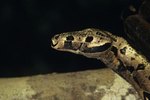
While nearly every carnivore and omnivore, including humans, are known to eat mice, they are only an occasional snack or meal of opportunity for some, while for others they are a dietary staple. Animals that depend on mice for food play an role in keeping rodent populations under control and limiting the spread of diseases that mice can carry. These animals are considered natural predators of mice since they eat them daily.
Cats
Cats of all sizes, wild and domestic, hunt and eat mice. Some people keep house or barn cats not only as pets, but as a means of controlling the mouse population. Smaller wild cats, like lynx, bobcats and wildcats depend on mice for a large part of their diet. Big cats, like jaguars, tigers and even lions use mice to supplement their diet, especially when other food sources are scarce.
Canids
Pet dogs generally don't have to rely on mice as a food source, but many of their wild cousins do, including foxes, coyotes, jackals and dingos. Wolves also frequently eat mice, and often seek them out as a food source during winter when larger prey is difficult to find. Domestic dogs, especially terrier types which were bred to hunt weasels, foxes and rats, are known to eat mice if given the opportunity and in some cases are trained to provide pest control.
Birds
Mice are a vital source of nourishment for birds of prey like owls, hawks and eagles. Crows, blue jays and heron also include mice in their diet. Barn owls are one of the top avian mice predators, with a single family capable of catching and devouring a dozen mice every night, giving them an important role in agricultural areas where mice can damage crops and stored grain.
Snakes
Snakes play a major role in controlling mice population since mice play a central role in the diet of many species of snakes around the globe. Because snakes can unhinge their jaws to swallow mice, both large and small snakes rely on them for sustenance. Under natural conditions, when the mouse population increases, so does the snake population; but in some areas too many snakes have been killed by humans, skewing the balance between prey and predator, resulting in mouse overpopulation.
Humans
While most people in North America would never dream of eating a mouse except in dire circumstances, in some cultures mice are part of a regular diet or are considered a delicacy. In some parts of China and Korea, baby mouse wine, which is a bottle of wine with a few small mice fermented inside, is served as a health treatment and a special treat. In both Zambia and Malawi, mice skewers and dishes are commonly sold at roadside stands. In Malawi, one of the poorest nations in the world, mice are caught in corn fields after harvest and then prepared as a meal.
References
Photo Credits
-
Jupiterimages/Photos.com/Getty Images




